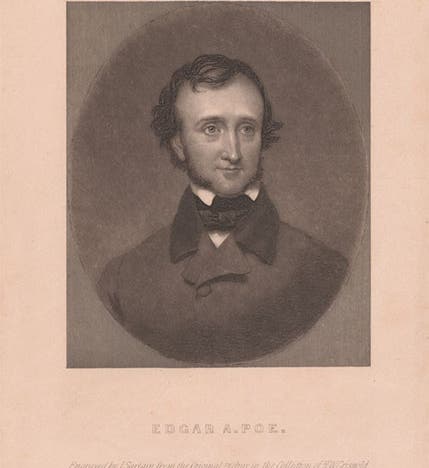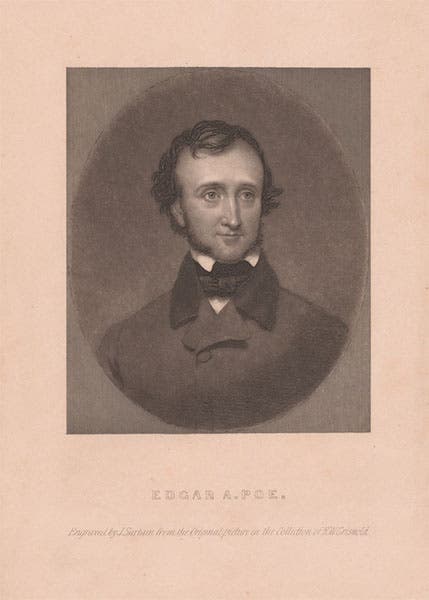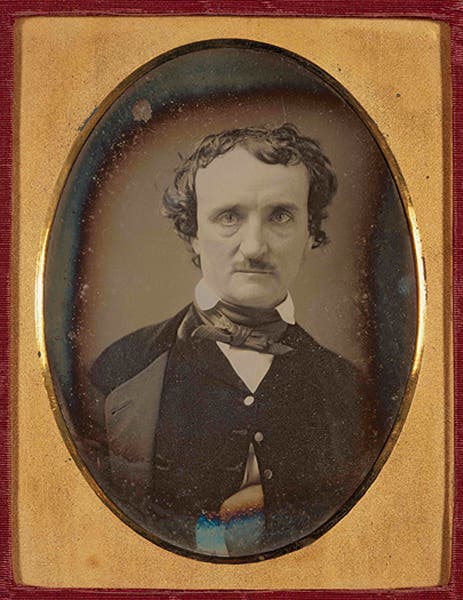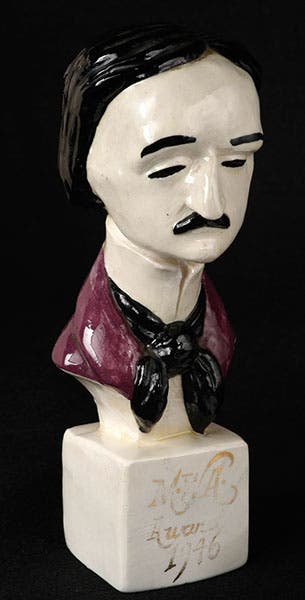Scientist of the Day - Edgar Allan Poe
Edgar Allen Poe, an American writer, editor, poet, and critic, was born Jan. 19. 1809 (just three weeks before Charles Darwin and Abraham Lincoln were born). Poe may be the best known of all 19th-century American authors, and he is often touted as the first American to earn his living entirely from writing, but he led a surprisingly difficult life, perhaps because he had no other income than literary fees, and that wasn’t much. He was born in Boston, grew up in Richmond (with five years of that upbringing spent in England), and then spent his literary life, all 20 years of it, in Baltimore, Philadelphia, and New York City. He was recognized early on as an extraordinary talent – when he submitted a portfolio of pieces to a writing contest sponsored by the Baltimore Saturday Visiter in 1833, the three judges, all legitimate critics, concluded that any one of Poe's stories was better than all of the rest of the entries, and they chose "MS. Found in a Bottle" as the winner of the $50 prize. His story "The Gold-Bug" won a $100 prize from Philadelphia’s Dollar Newspaper in 1843. But such awards, while recognition of his writing talent, were not typical in their monetary compensation – he was paid $9 for “The Raven” by The American Review in 1845, and it was published anonymously, although his name was soon attached, and the poem did bring him nation-wide fame. But not much money.
Poe is not usually mentioned in the same breath as "American science," although scholars have long been aware of the considerable scientific knowledge displayed in the two stories already mentioned, and in several of his hoaxes, such as "The Unparalleled Adventure of One Hans Pfaall" (1835), about a balloon ride to the Moon, and "The Balloon-Hoax" (1844), with details of a supposed transatlantic balloon flight by a well-known balloonist, Monck Mason. But recently, an American scholar, John Tresch, a historian of science and technology now at the Warburg Institute in London, has attempted to move Poe closer to the currents of American science with a book, The Reason for the Darkness of the Night: Edgar Allan Poe and the Forging of American Science, (2021). I don’t know as I was convinced that Poe belongs in a discussion of American science of the 1830s and 1840s – I think Poe used science to add authenticity to many of his stories, especially those designed to hoodwink, but he was really too much of a romantic to have anything in common with Joseph Henry and Alexander Dallas Bache, the preeminent American scientific figures of his day. Nevertheless, Tresch’s book is an excellent biography, and quite different from the kind of biography you would get from a student of American literature, in that Tresch is less opinionated about the true meaning of many of Poe’s writings, some of which have excited a wide variety of interpretations.
In addition to reading Tresch’s book, I reread some of Poe’s tales for the first time in many years – all of the ones so far mentioned, and a few more, and of course “The Raven.” I must say they are still quite enjoyable to read, and still exciting. One can see why the appearance of a new Poe story or poem was such an anticipated event in American literary circles in the 1840s. I also reread the three C. Auguste Dupin mysteries – “The Murders in the Rue Morgue” (1841), “The Mystery of Marie Rogêt” (1842), and “The Purloined Letter” (1844), since Poe here invented the modern detective, the prototype of Sherlock Holmes and Hercule Poirot, and the modern detective story, and one might argue that the intellectual make-up of Dupin, that of the arch-observer and arch-logician – the supreme “ratiocinator”, as Poe calls him – makes him a scientist by loose association. It is hard to keep in mind, when reading “The Murders of the Rue Morgue,” that there had been nothing like C. Auguste Dupin in all of American literature before Poe, or in European literature for that matter. Poe created an entirely new genre out of nothing but his bubbling mudpot of a mind.
Poe’s life was sad, in spite of his literary success. He was always scrambling for food and sometimes shelter; his frank criticisms, especially of Boston’s literary circle, earned him enemies; and he battled alcoholism his entire life. He lost his young wife (his first cousin) to tuberculosis. He was on the verge of finally getting his own journal in 1849, when he died suddenly of unknown causes, at the age of 40. Even after his death, he had to suffer from a virulent obituary written by a literary enemy, Rufus Griswold. His reputation took quite some time to recover. But recover it did, happily.
Poe scholars – and the reading public – are well-served by an exceptional website, eapoe.org, run by the Edgar Allan Poe Society of Baltimore, which contains all of Poe’s writings and much of the secondary literature. For example, if you want to find one of Poe’s tales, here is the “Tales” page, where there are links to every one of his stories and the principal novels as well. To get you started, here are the main pages for” “The Balloon-Hoax” and “The Murders in the Rue Morgue.” Choose the version of the text you want to read and enjoy immersing yourself in a story by a master of mystery and suspense, if not of science.
There are many likenesses of Poe, from which we selected two – a mezzotint of 1849, copying a painting of 1845 that shows a more amiable Poe (first image), and the so-called “Annie daguerreotype” of 1849, which captures an agonized man who appears not far from death, as indeed he wasn’t (third image). My favorite likeness is the Edgar statuette, given to winners of the annual Edgar Awards offered by the Mystery Writers of America. The first statuette awarded, in 1946, is in the amazing Poe Collection at Cornell University Library (fourth image).
There are many modern likenesses of Poe. I think every house he ever lived in – and there were many – is now a Poe Museum of some sort, usually with a piece of commissioned art. We show you a recent addition to the scene in Boston, a statue of Poe and a raven, trailing papers across the Edgar Allen Poe square. Considering everything demeaning that Poe had to say about the city of his birth, it is amazing that he has a statue at all. I look forward to seeing it in person.
William B. Ashworth, Jr., Consultant for the History of Science, Linda Hall Library and Associate Professor emeritus, Department of History, University of Missouri-Kansas City. Comments or corrections are welcome; please direct to ashworthw@umkc.edu.











